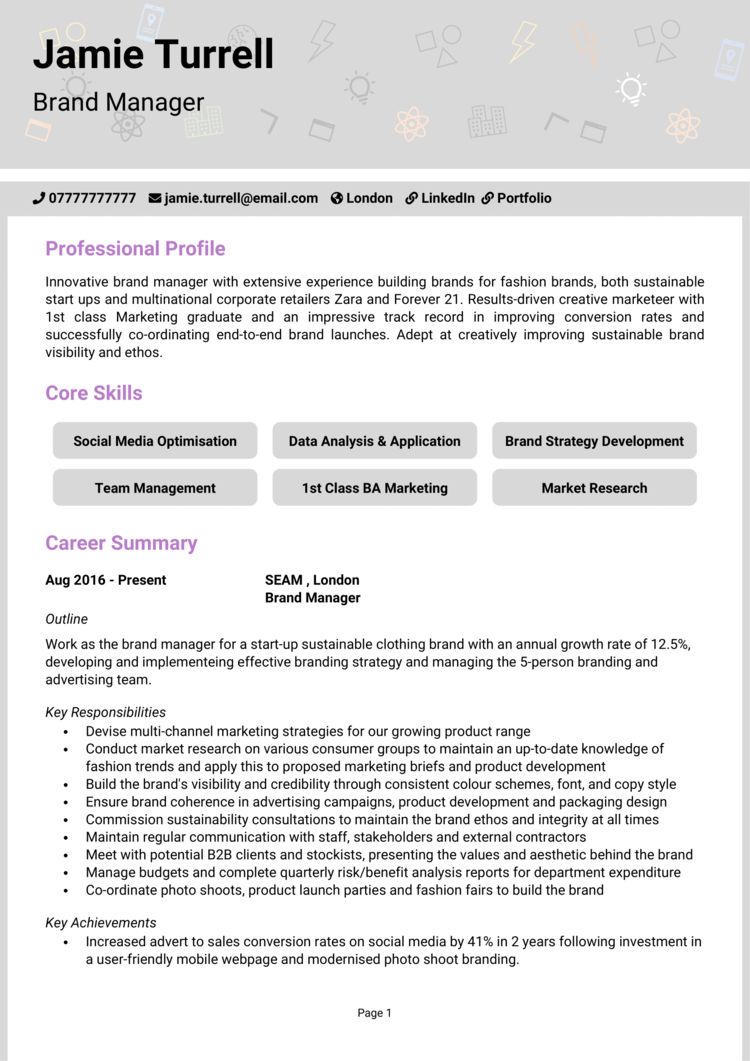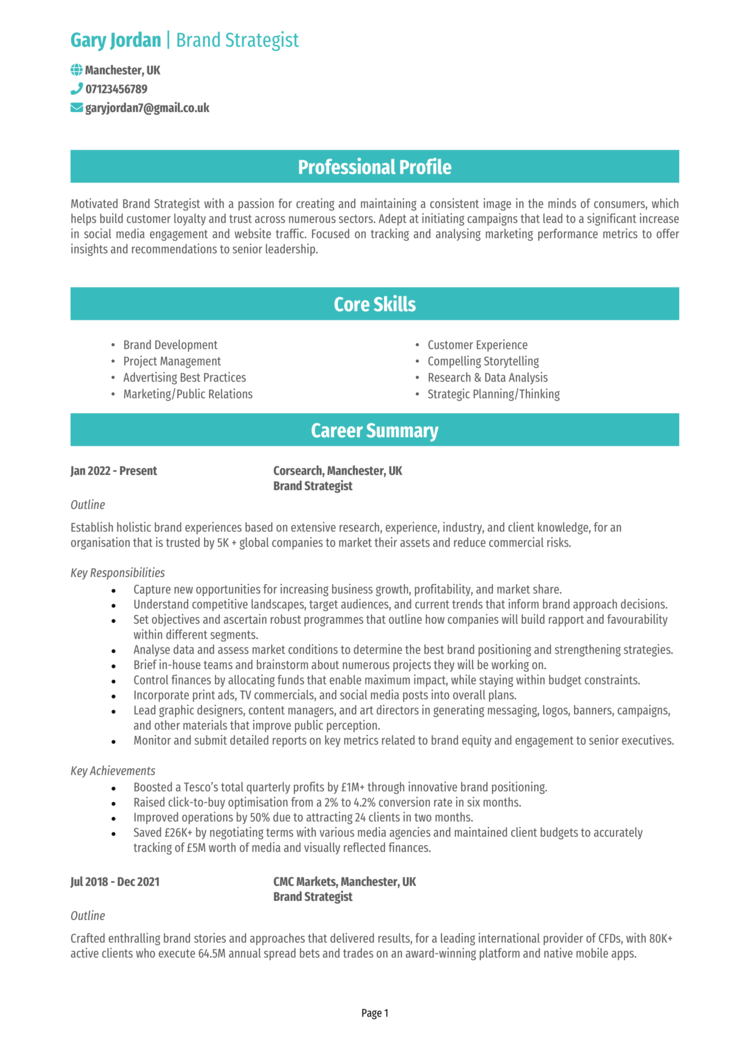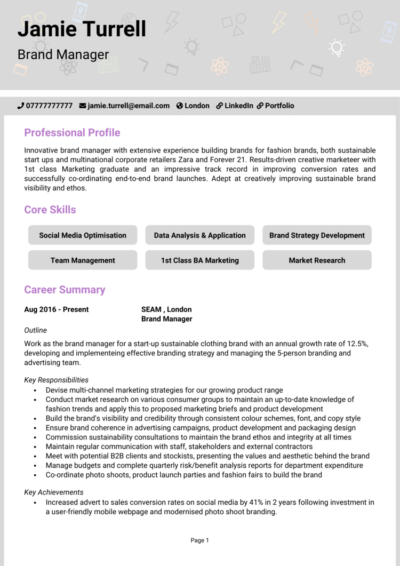Every product has a brand. But behind every successful brand is someone making sure it stays relevant and trusted – you. You can handle all the hard work, but the only brand that matters right now is yours.
This guide (complete with 3 Brand Manager CV examples) will walk you through how to turn your experience into a compelling application that convinces hiring managers of your skills, in order to land you new marketing roles.
Brand Manager CV

Brand Strategist CV

Brand Ambassador CV

How to write your Brand Manager CV
Discover how to craft a winning Brand Manager CV that lands interviews with this simple step-by-step guide.
You already know how to align content, messaging, and visuals to create a memorable brand – your CV should be no different. It’s your personal brand deck: a strategic summary of who you are and what you bring. Think of it less like a formality and more like a pitch – one that gets you called in for the next round.
Over the next few sections, you’ll learn how to organise your background, shape your messaging, and communicate your career like a brand you believe in: writing a CV like this will bring you much closer to the role you deserve.
What’s the right way to structure and format your Brand Manager CV?


Brand managers understand the importance of structure – whether it’s a rebranding timeline, campaign rollout, or internal brand playbook. Your CV should show that same sense of order and intention. Recruiters want to see the substance of your work, not hunt for it, so it’s important your layout supports fast reading and clarity of messaging.
Here’s the layout to follow:
- Name and contact details – Place personal details at the top so employers can get in touch easily.
- Profile – Kick things off with a concise overview of what makes you the ideal candidate for the job.
- Core skills – Briefly highlight those qualities which make you the best candidate
- Work experience – List your previous roles in reverse chronological order, with your most recent first.
- Education – Go through the academic history which underpins your expertise
- Additional info – This optional section can include professional memberships, awards, or hobbies that showcase your fit for the role.
Use bullet points in your experience section to highlight your key responsibilities and achievements – this improves readability and allows recruiters to quickly spot your commercial wins and leadership roles. Keep each section well-defined with clear headings and avoid cramming too much into one block.
Opt for a clean, readable font and professional layout that enhances – not distracts from – your content. And finally, stick to a two-page maximum length to keep your messaging sharp and focused. A well-presented CV format which follows these tips reinforces your credibility as someone who understands how structure and design support communication.
How to create a Brand Manager CV profile


Think of this section as your value proposition. Just as you’d position a brand to resonate with its audience, this short paragraph should introduce you as a strategic, commercially aware leader with a track record of shaping brand identity and driving business growth.
Use your CV profile to summarise the industries you’ve worked in and the scale of the brands you’ve supported. You want to convince recruiters of the value you’ve brought to past roles, and how you’ll continue to bring it at their company.
Brand Manager CV profile examples
Profile 1
Experienced Brand Manager with over six years of success managing end-to-end brand strategy across consumer goods and lifestyle sectors. Skilled in market positioning, campaign development, and cross-functional collaboration. Proficient in tools such as Adobe Creative Suite, HubSpot, and Google Analytics. Known for developing consistent brand messaging and driving measurable growth through innovative marketing efforts.
Profile 2
Creative and commercially minded Brand Manager with five years of experience building and evolving brand identities across retail and digital platforms. Adept at aligning visual identity and tone of voice with audience insights and market trends. Strong track record in launching multi-channel campaigns, managing budgets, and delivering consistent brand performance.
Profile 3
Strategic Brand Manager with seven years of experience leading brand development and product marketing in fast-paced FMCG environments. Expertise in competitor analysis, campaign execution, and managing agency partnerships. Known for balancing creativity with data-driven decisions to enhance brand equity and customer engagement.
Details to put in your Brand Manager CV profile
Here’s what to include:
- Where you’ve worked – Agencies, FMCG, retail, tech, or corporate brands.
- Your top qualifications – Degrees or relevant training in marketing or brand strategy.
- Essential experience – Campaign leadership, brand development, stakeholder collaboration.
- Sectors or audiences – B2C, B2B, global, local, or niche industries.
- Business outcomes – Engagement, awareness, loyalty, or sales uplift driven by your work.
Presenting your core skills


Instead of simply listing buzzwords, use this section to subtly reinforce your brand thinking. Treat it like a curated overview of your approach – showing you understand what’s relevant to the employer and what they need from a brand manager.
Keep this section tailored and considered. You don’t need to include every single skill – just make sure it reflects your areas of expertise and your ability to align brand direction with business goals. A well-chosen selection here can reinforce the idea that you bring both creative vision and commercial focus.
Essential skills that recruiters look for in a Brand Manager CV
- Brand Strategy Development – Creating and executing long-term plans to build brand equity and ensure consistent positioning in the market.
- Market Research and Consumer Insights – Analysing customer behaviour, trends, and competitor activity to inform brand decisions.
- Campaign Planning and Execution – Leading integrated marketing campaigns across digital, print, and broadcast to boost brand awareness and engagement.
- Visual and Verbal Identity Management – Ensuring consistency in logo usage, tone of voice, and messaging across all channels and materials.
- Cross-Functional Collaboration – Working closely with product, marketing, sales, and design teams to align brand initiatives with business goals.
- Performance Monitoring and Reporting – Tracking KPIs such as brand awareness, perception, and campaign ROI to measure success.
- Budget Management – Allocating and overseeing brand budgets efficiently to maximise return on investment.
- Agency and Vendor Coordination – Managing relationships with external agencies for advertising, design, and PR execution.
- Product Positioning and Messaging – Defining value propositions and key messages that differentiate products in the market.
- Innovation and Trend Analysis – Staying up to date with industry trends to ensure the brand remains relevant and competitive.
How to highlight work experience


This is where you move from storytelling to proof. You’ve likely worked across campaigns, product launches, partnerships, and internal communications – now it’s time to translate that into focused, result-led entries.
List your roles in reverse order, starting with your most recent. For each bit of work experience, include your job title, employer, and the dates you worked there. Follow with bullet points that cover your responsibilities and measurable contributions. Think of each entry as a mini case study: what was the brand challenge, what did you do, and what was the result?
How to make your past experience easy to read for employers

- Outline – Briefly explain the company, your role, and the brand context.
- Responsibilities – Use action verbs like “led,” “positioned,” “developed,” or “launched.”
- Achievements – Highlight results: “Increased brand recall by 30%,” “Led full rebrand across 5 markets,” or “Boosted campaign engagement by 65%.”
Example job entries for Brand Managers
Brand Manager | Aurora Skincare Co.
Outline
Led the brand strategy and marketing execution for a premium skincare brand, overseeing product launches, creative direction, and customer engagement across online and offline channels.
Responsibilities
- Developed and implemented brand positioning, messaging, and visual guidelines.
- Planned and managed marketing campaigns including social, influencer, and email marketing.
- Conducted consumer research and competitor analysis to inform brand direction.
- Collaborated with product, sales, and design teams to ensure consistency across touchpoints.
- Managed external creative agencies and monitored brand performance metrics.
Achievements
- Increased brand awareness by 35% within 12 months through targeted digital campaigns.
- Successfully launched three new products that exceeded projected sales by 20%.
- Helped the brand gain national retail partnerships through rebranding and messaging updates.
Brand Manager | Trailpoint Outdoor Gear
Outline
Managed all aspects of brand development for a growing outdoor lifestyle company, from digital content strategy to packaging and promotional events.
Responsibilities
- Refreshed brand identity including logo, packaging, and online presence.
- Planned and delivered seasonal campaigns across social media, email, and retail promotions.
- Analysed consumer behaviour and sales data to refine marketing strategy.
- Worked closely with creative teams to develop compelling storytelling and visuals.
- Maintained budget control and ensured campaign ROI targets were met.
Achievements
- Boosted e-commerce sales by 50% following a full website and brand refresh.
- Doubled Instagram engagement through a new content strategy and influencer collaborations.
- Won a regional marketing award for brand campaign innovation and effectiveness.
Brand Manager | Lexgrove Beverages
Outline
Directed brand strategy for a national soft drinks brand, overseeing product marketing, packaging, and promotional activity across trade and consumer markets.
Responsibilities
- Led brand planning and annual marketing strategy development.
- Managed product launch timelines, packaging design, and in-store POS campaigns.
- Coordinated national advertising efforts including TV, radio, and digital media.
- Worked with category and insights teams to assess brand performance and adjust positioning.
- Built and maintained relationships with retailers, distributors, and promotional partners.
Achievements
- Improved shelf presence and increased retail sales by 22% through strategic POS design.
- Secured coverage in three major national publications following a brand-led PR push.
- Developed a sustainability-focused sub-brand that won industry recognition.
Education and qualifications


This section backs up your expertise with the relevant qualifications. If you’ve got a degree in marketing, branding, business, or communications, list it first. Follow with any certifications or short courses that add weight to your CV.
While brand experience speaks louder than a certificate, showing that you’ve built your knowledge formally adds professional credibility – especially in competitive brand leadership roles. That said, keep your education section concise to save space for your experience.
Qualifications recruiters look for in a Brand Manager
- BA or MA in Marketing, Branding, Communications, or Business – Offers a strong foundation in market research, brand strategy, and consumer behaviour.
- Chartered Institute of Marketing (CIM) Qualification – Recognised accreditation that validates your strategic marketing knowledge and professional development.
- Brand Strategy or Design Thinking Courses (e.g. IDEO, Coursera, FutureLearn) – Demonstrates your ability to build customer-focused brand frameworks and creative problem-solving.
- Digital Marketing Certifications (Google, HubSpot, or Meta Blueprint) – Confirms your grasp of content, campaign management, and digital branding techniques.
- Leadership or Project Management Training (e.g. PRINCE2, ILM) – Shows you can lead teams, manage timelines, and deliver brand initiatives efficiently and effectively.





